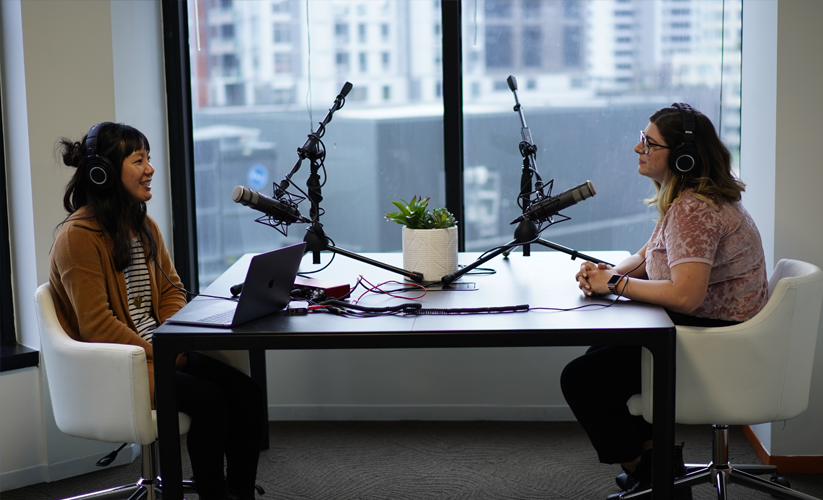Shawnna Sumaoang: Hi, and welcome to the Sales Enablement PRO podcast. I am Shawnna Sumaoang. Sales enablement is a constantly evolving space, and we’re here to help professionals stay up to date on the latest trends and best practices so they can be more effective in their jobs.
Today I’m excited to have Emily Garza with us from Fastly. Emily, I’d love for you to take a minute and just introduce yourself, your title, and your organization.
Emily Garza: Thanks, Shawnna. As you said, my name is Emily Garza. I work at Fastly, a leading-edge cloud platform, and we help our customers deliver the best online experiences possible to their end-users. Currently, I am the director of account management but also started at the sales enablement function here at Fastly.
SS: Emily, you and I have worked together a lot on the Sales Enablement Soirées that you’ve participated at in San Francisco over the last few years, and a lot of the conversation often revolves around the pre-sales world, especially with regard to enablement. But you focus on post-sales customer interactions. Why is that important for sales enablement?
EG: Many of the businesses today are moving into the SaaS world, and having to regain customer trust and engagement month-over-month. This business structure means that the first sale that the pre-sales team is making is typically only the first touchpoint with the customer. We need the account management, our customer success team, to really be engaged to keep the customer and ideally find growth opportunities. So, as this function becomes a lot more critical to consumer engagement and growth with the customer, focusing on enabling that team becomes extremely critical for a sales enablement function as well.
And due to enabling this, what I’ll call the “secondary salesforce”, this is why sales enablement needs to focus not just on the pre-sales but also the post-sales organization. Because that’s where a lot of the organic and follow-up growth is happening with these “land and expand” type deals.
SS: Absolutely, and you have a wealth of experience in sales enablement. So, how has that helped you in your current role developing the account management org at Fastly?
EG: Yes. So, starting sales enablement from the ground up is definitely difficult. One of the biggest pieces strategically that I’ve learned is gaining alignment and buy-in. If you don’t have that from the key stakeholders, it’s really a struggle to be effective in a sales enablement-type role.
I went to a conference over the last year and one person described it as not just getting buy-in as someone’s word saying that they’re supporting you, but actually demonstrating that in action, which I think is so critical. I know a lot of people who are in sales enablement have struggled with general, initial support on a program or training that they’ve rolled out. But when push comes to shove and you’re reliant on the managers to help coach and follow up on some of the things, that’s where you run into struggles. So, making sure that you gain alignment on the overall strategy and really have buy-in both on the words and in the actions from those you’re going to be reliant on.
The second piece that I’m taking from the sales enablement role into this focus on account management is more tactical. So, things like creating playbooks, working on our product pitch as we look at up-selling and expanding our relationships with customers, as well as specifically identifying metrics.
SS: I love that. How does your approach to sales enablement differ between pre and post-sales teams given your experience in both? How are you building enablement into post-sales roles like account management at Fastly?
EG: So, there are many things that in name are similar. But as you look at a post-sales role, they might need a little bit of nuance or tweaking specifically for that post-sales function. One thing that I mentioned was playbooks. So, this is now not just looking at how to identify an ideal customer profile, but we’re looking at how to conduct key value-driving activities. These might be things like business reviews, renewals, being able to tie in not only the upselling growth opportunity but the idea of longevity with the customer.
Another similar piece is product pitches, so not only do we need to be able to detail what our product does and some of the general value benefits of that, but we need to be able to hone in and be very specific in what the benefit is for that company. We’ve had the luxury as a post-sales organization of getting to know them throughout the life cycle, understanding why they bought the solution initially, and really being required to provide that information with up-sell opportunities.
Sometimes I think sales is able to more generically customize the pitch, as they’re still learning all of those customer details. But for the AM team, it’s an expectation that you have that understanding. Anything that you are talking about in terms of a growth opportunity, it’s very customized to the customer that you’re working with.
As we look at the AM-specific roles and those post-sale pieces, another key focus for our enablement is around negotiation training. This is also critical for the sales role, but I think the nuance and perspective here is really along negotiating but also building that long-term relationship. So, finding those values that we can align on, really understanding the critical pieces of evaluation for customers so that we can focus on those and make sure we get to some sort of win-win solution for both parties.
We’re also honing in on more AM or post-sales specific things such as product roadmap. So right now, we’re working on building out product roadmap certification. How our structure is set up is we’d like to invite product to as many meetings as possible — customers are always interested in hearing about the roadmap and some of the future things that we’re looking at — but being realistic in terms of the kinds of customer meetings and everyone’s busy schedule. We can’t always have product in the room with us. So, making sure that our post-sales team is well-versed in what is coming up and being able to present that to the customer.
By creating this certification, it ensures that the team is ready and prepared to present that in a way that we’ve agreed on as the baseline. And it makes sure that this understanding is demonstrated rather than continually having the “I’ll go back and check on that”, which you have to certainly use in some circumstances, but it doesn’t always build confidence for the customer. So, making sure that we’re able to have a baseline around what we expect around this presentation has been important.
SS: I think that is spot-on, especially for account managers. They often need to have a knowledge base that they can tap quickly so that they can continue to add a lot of value in their relationship with their customers.
I also want to ask you a little bit about how you think about onboarding a post-sales or account management-type team. How is that different than sales onboarding?
EG: Yeah, great question. So, we do a lot of the sales onboarding with the account management team. I think it’s critical to have them understand the full cycle of the process so that as they start to get engaged with the customer, they understand the experience they may have had through working with an SDR-type team, working through the sales process. They need that context to be able to continue through the customer relationship. So, we go through the typical sales onboarding, we also do things such as call shadowing, learning the product pitches.
Where some of the nuances come in for the account management team is when we shadow calls. They’re shadowing calls across the entire customer lifecycle. This is doing some pre-sales calls as well as some post-sales calls, really understanding all of those different touchpoints so we have a really good understanding of the customer’s experience. While we’re doing those shadows, we often build in some pre-work and post-work where they’re sitting down with whoever is hosting the call, understanding the objective, and then having a post-call to make sure that they understood if the objective was met, be able to ask any questions on terminology and things that had come up during the call.
Another piece, which is less concrete, is really a focus on internal relationships. So, as an account manager or anyone with that post-sales ownership responsibility, our success is really based on the internal relationships we form to be able to be a customer advocate. One of the things that’s very important as an account manager starts to ramp up here at Fastly is making sure that we have proper introductions and relationship-building to teams like product, to marketing, to finance, so that they can understand how best to communicate with them so that our customer asks are clearly communicated and ideally moved forward.
SS: How do you go about measuring success around enablement in a post-sale, customer-type role?
EG: So, when we look at metrics, it’s really not as clear-cut sometimes as a pre-sales role where you have a quota and you’re selling against that quota. Here, we do have a revenue goal where we’re looking to continue engaging and grow our customers. I think that’s pretty typical in a post-sales organization. But we’re also looking at some less tangible items that are really focused on how we’re engaging with our customers. That might be things like, do we have a really good understanding of what their use case is? New growth opportunities, how’s our NPS score, and are there things that we can do to better and gauge and increase that?
I mentioned revenue — lowering churn or even impact on write-downs. So, as we go through a renewal, not giving away the farm but finding a negotiation that works for both parties. Really understanding where that customer value is being driven in making sure we’re focusing the discussion around there.
SS: Let’s flip the roles a little bit. How can a post-sales team help the enablement role?
EG: Yes. So, I think with any good, symbiotic relationship, there needs to be a little bit of give-and-take between different roles. And sales enablement a lot of times is seen as this giving role: giving training, giving coaching. But there are a lot of things that enablement can get both from sales but also from post-sales teams. When I think about the role that post-sales teams can own is giving feedback to enablement that is really around providing use case data. So, as we get further into accounts, we gain a deep understanding of how our customers are working with us and how they’re leveraging our solutions to impact their business. Bringing those use cases back to sales enablement to be able to build into things like pre-sales white papers and things like that is very critical.
I think there’s also an opportunity to allow enablement to listen in on existing customer calls. I know when I was in the sales enablement role, one of my continual asks to the sales team was being able to hear directly from customers how our positioning was working, making sure that I was getting visibility rather than just sharing with the sales team, seeing how effective it was out in the field. I know some sellers shy away from that. There’s this precious balance as a prospect to make sure that a customer or a prospect is going through this established process, and you don’t want to introduce too many new faces throughout that. Having a post-sales team that has got that comfort level with the customer, it gives a little bit of flexibility to allow enablement to come in and shadow some of those calls and hear that customer feedback directly.
SS: What are some of the ways in which you’ve motivated post-sales teams to engage and help enablement? Obviously, compensation is a big motivator on the presale side of the house, but how do you drive that motivation with the post-sales team?
EG: It’s a great question. Ours is not driven by compensation, but I think a lot of it is driven by team culture. So, one of the earlier podcasts that I had been listening to on Sales Enablement PRO was around a culture of learning. I think that that is so amazing and it’s really the culture that we’re trying to build here. So, I frame the benefit of being on the account management team as being that customer advocate, being able to make those connections, as well as a big focus around feedback. That includes getting people of various roles within the company to become involved in customer conversations, in brainstorming for customer meetings, and things like that. Sales enablement falls into that group of people that we want to partner with, we want to both gain learning from and share learning with.
SS: As a closing question, given your holistic view on sales enablement, I would love to understand the top two trends in your opinion in sales enablement that you’re seeing in the market today.
EG: Sure. The first one is really an adjustment to different learning styles. In the past, we’ve gone from this all-day classroom training, and we’re getting away from that one-size-fits-all. I’ve heard a lot of discussion on bite-size, just-in-time learning. Even within that, there are levels to adjust based on different learning styles. That might be audio, that might be video, it might be written, but getting an understanding of your salesforce either pre or post-sales and how they learn to be able to deliver information in the most effective way based on their different learning styles.
The second piece, and I’ll admit I’m a little bit biased here, but also rethinking enablement just from being pre-sales to anything that’s customer-facing. Then, it becomes really critical to make sure that we have uniform messaging, uniform processes across all of the organization that’s interacting with customers. In a SaaS business, that can’t just stop that initial sale.
SS: I couldn’t agree more. I think enablement has a lot of impact on the entire customer experience with an organization, so I think you’re spot-on with that one. Thank you, Emily, I really appreciate your time today.
EG: Thank you so much.
SS: Thank you to our audience for listening. For more insights, tips, and expertise from sales enablement leaders, please visit salesenablement.pro. If there is something you’d like to share or topic you want to learn more about, please let us know. We’d love to hear from you!




